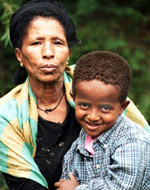A Partnership with the Ethiopian Orthodox Church to Combat HIV/AIDS
A Vicious Cycle
- Ethiopia has a large and extremely vulnerable population of 74.7 million, with an estimated 50 percent of the population living below the poverty line
- HIV/AIDS remains one of the key challenges for the overall development of Ethiopia, as it has led to a seven-year decrease in life expectancy and a greatly reduced workforce
- Brain Drain (over 2/3 of professionals leave after receiving their degrees).
- Reduced productivity, civil conflict, poor farming conditions, and recurrent droughts leave six to 13 million people at risk of starvation each year.
- Knowledge of HIV prevention, primarily CONDOMS is lowest in Ethiopia: compared to its neighboring countries; only 40% of women and 68% of men know that using a condom using sexual intercourse can help reduce their chances of getting HIV/AIDS; in comparison to some neighboring countries where 68% in Uganda and 79% in Tanzania know the preventative effects of condoms.
- More adults die from HIV or AIDS related illnesses than any other cause of disease.
- 1.5% of Ethiopians in the age group 15-49 are infected with HIV (very low estimate).
- Urban areas are very high risk compared to rural areas: About 6% of adults are HIV positive vs. 1% in the rural areas (low estimate) and some studies have shown when they have tested different sections and clusters of Ethiopia's urban areas for prevalence to range from 1%-23%.
- Women are twice as likely as men to be infected with HIV. (1.9% of women vs. .9% of men)
- As in many African countries, HIV is highest among the wealthiest and most educated households: 4.3% of the wealthiest households vs. .5% of the poorest households are HIV infected. (low estimate, selection bias)
- In Ethiopia, over 40% of the population are under fifteen years old and many of them have lost their parents to HIV/AIDS related illnesses. http://www.pepfar.gov/press/countries/profiles/116132.htm

